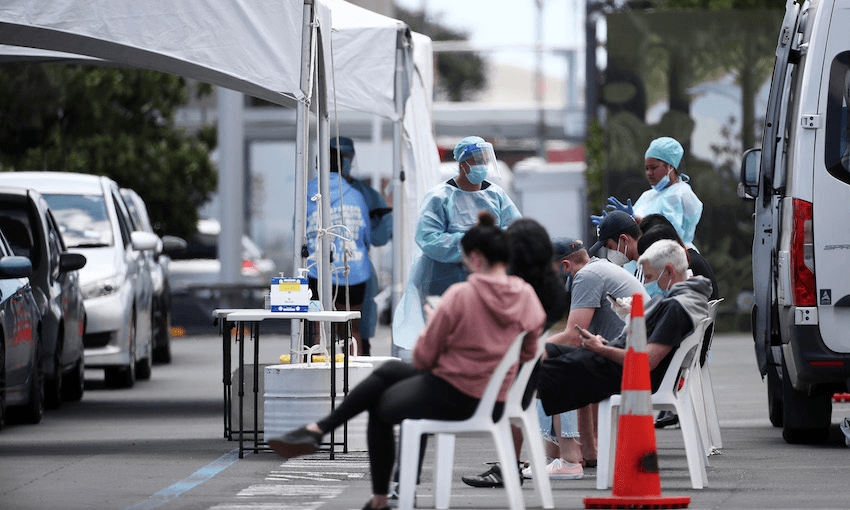More than two months ago, an urgent review of New Zealand’s Covid-19 testing system was delivered to the government as the country’s largest coronavirus cluster burned through Auckland. It still hasn’t been made public.
New Zealand’s confidence in its Covid-19 border defences was at a low ebb in August as a cluster of cases in Auckland grew quickly, origins unknown, leading to a second lockdown across the city.
To help calm public anxiety, then health minister Chris Hipkins ordered an urgent review by Sir Brian Roche and Heather Simpson of the country’s surveillance and testing system. The first draft of that review was finished just over a month after it was commissioned, landing on Hipkins’ desk on September 30.
Over two months later, the review still hasn’t been released to the public or anyone outside the health ministry. Information about the document has come out of the ministry and the office of now Covid-19 response minister Hipkins in drips: the report is critical of the health ministry, people are named in it, and the ministry itself is now unhappy with some of the criticism.
Hipkins confirmed this week that the review should be released before Christmas.
The August outbreak eventually grew to 179 cases and became the country’s largest cluster of Covid-19. The renewed lockdown cost the country $440 million per week in lost jobs and productivity. While the first known case was linked to an Americold cold storage facility, the path the virus took back into New Zealand still hasn’t been established.
Roche and Simpson were called into a situation where the public learned in August that border workers were not getting tested at anything close to the rate cabinet had expected. Nearly two months after the public was told all border-facing workers were getting regular swabs, nearly two-thirds had never been tested as the outbreak erupted in mid-August.
Director general of health Ashley Bloomfield would describe the bungled testing as the result of “dissonance” between the cabinet’s expectations and what it was being told by the health ministry. At that point, what started off with some workers at Americold had spread among a church congregation in Mt Roskill and was spinning off sub-clusters across Auckland.
The Roche-Simpson review is understood to look closely at that testing situation.
“It makes some constructive recommendations, it highlights some areas where they think the Ministry of Health could have done better,” Hipkins told reporters at parliament this week.
“It certainly unpacks what in the review panel’s view could have been done better to avoid a situation where the cabinet expected a degree of testing to be happening that wasn’t actually happening,” he continued.
There won’t be job losses from the review, but “reporting lines” will change, said Hipkins. The machinery of government will be retooled in its response to Covid-19. Which is not unexpected, as Hipkins himself is the head of a ministry that didn’t exist a few weeks ago.
The country is entering a difficult period at the border over the next month and the review’s findings could be important for the public to understand what’s happening, said University of Otago epidemiologist Michael Baker.
“This is arguably the highest-risk period for New Zealand, so we need to have this report to have a public debate about what needs to be done,” he said.
The country’s border facilities will be at capacity over the Christmas break and all the way to February, while staffing will be stressed by holidays. The remaining nurses and doctors are expected to face more work. Covid-19 is breaking records globally, with more cases appearing daily in New Zealand’s international arrivals.
“We’re all in this together. The government’s response has been very transparent at various points and that helps to build and maintain trust. This monitoring must be transparent and shared as soon as possible,” said Baker.
The final version of the review was handed to Hipkins in late November. He said the government hasn’t delayed the review’s release, however cabinet wants to have acted on it and ordered changes before the contents are made public.
Chris Bishop, National’s health critic, calls the lack of release an unacceptable delay.
“It’s worth remembering the context in which it was commissioned, a real failure at the border and real concerns around our border tracking systems. It was commissioned under urgency, the government’s chief sorter outer of problems, Sir Brian Roche was duly sent in, alongside Heather Simpson, and given only a month to report back,” he said.
According to Bishop, the timeline here should be easy for anyone to understand. A critical report was quickly written in a month and handed over. Then for two months, the health ministry and the independent reviewers tinkered with the final report in a bureaucratic game of tennis. With the country eyeing a summer holiday, it still hasn’t seen the light of day.
“We need to make sure that what happens at the border is absolutely watertight, and if there’s a report out there that says that in past it hasn’t been, we deserve to see it and we deserve to know what the government is doing to fix it up,” said Bishop.

